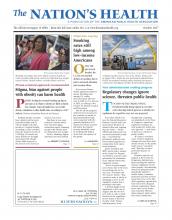People looking for research backing up almost any topic as it relates to obesity are likely to find it. For example, waist circumference, not overall obesity, contributes to other health risks, according to a 2017 study in Diabetes Metabolism Research and Reviews.
Perhaps people can both have obesity and be metabolically healthy and fit, with no higher risk than people at a normal weight, according to 2012 research from the European Society of Cardiology. Or maybe too many deaths are wrongly associated with obesity, shows 2005 research in the Journal of the American Medical Association.

Shaming and stigma have been linked to poorer health outcomes in people with obesity, and do not help them lose weight, research shows. Health workers can help address such bias.
Photo courtesy Obesity Action Coalition
But there is one topic related to obesity where time and time again, researchers agree: Shaming people with obesity does not help them lose weight.
In fact, shaming, stigma and bias have been linked to poorer health outcomes. Research from the Perelman School of Medicine at the University of Pennsylvania published in January in Obesity shows that “fat shaming” — discrimination, poor service, harassment and negative attitudes toward people with larger bodies — is linked to higher rates of metabolic syndrome and high triglycerides, which can lead to stroke or heart attack. And 2014 research, also in Obesity, shows that shaming does not encourage weight loss and that it may be linked to weight gain. And stigma is on the rise, according to research by Rebecca Puhl, PhD, deputy director for the Rudd Center for Food Policy and Obesity at Yale University.
With more than one-third of Americans living with obesity, health workers and advocates are working to find new ways to address the issue. In 2013, the American Medical Association classified obesity as a disease — a step that should help address some of the stigma surrounding the condition, said William H. Dietz, MD, PhD, chair of the Sumner M. Redstone Global Center for Prevention and Wellness at the Milken Institute School of Public Health at the George Washington University and co-chair of The Lancet Commission on Obesity.
People with obesity are often blamed for their condition: Think of “eat less, move more” language, or talk about self-control or discipline when it comes to weight. A change in language helps reframe things, experts say. Health providers or public health workers do not refer to “cancer people,” for example, but “people with cancer.”
“I think providers…may not admit that they have a bias, but many may have a sense of revulsion when they’re dealing with a patient with obesity,” Dietz, an APHA member, told The Nation’s Health. “If a person is ‘an obese person,’ they’re held responsible for that. Their person is indistinguishable from their disease. ‘A person with obesity’ separates the person from their disease.”
Referring to obesity as a disease has another benefit: Its treatment can be covered by insurance. But that does not mean people with obesity all must seek the same treatment, or be on diets. In fact, they may never live without obesity. But medical interventions that help people lose 5 to 10 percent of their weight — which for many Americans would still be in the range of obesity as designated by body mass index — have shown significant improvement in people’s metabolic outcomes, lowering risk of Type 2 diabetes, cardiovascular disease and fatty liver disease.
Identifying obesity as a disease — or as a pandemic, according to Scott Kahan, MD, MPH, director of the National Center for Weight and Wellness and medical director of the Strategies to Overcome and Prevent Obesity Alliance — helps put urgency behind it, prompting more research, more funding and better treatment for people. But there can be unintended consequences that can contribute to stigma, Kahan said: Urgency suggests immediate and drastic action needs to be taken. That does not work for sustained weight loss or health overall. In fact, research published in 2016 in Evolution, Medicine and Public Health showed what many yo-yo dieters know all too well: Quick weight loss almost always comes back — often leading to a net weight gain.

Health workers are encouraged to look at the causes of poor health in people with obesity instead of focusing on body size.
Photo by LuminaStock courtesy iStockphoto
“Epidemics inherently require an urgent approach. However, obesity is a lifelong management issue, and in many cases approaching it with urgency can backfire,” Kahan told The Nation’s Health. “This is especially an issue in kids, where I frequently see parents so upset…about their kids’ weight that they push and overwhelm kids with messages about weight loss, exercise, healthy eating or the like, which can lead to poor body image, de-motivation for healthful behaviors and other sequelae.
“I can’t tell you how many patients say that their self-esteem took a terrible turn for the worse and lifelong body image issues started when their moms/ dads forced them to go to Weight Watchers or ‘fat camp’ or the like.”
For this and other reasons, not all health professionals and advocates agree that obesity should be classified as a disease. Linda Bacon, PhD, MA, a researcher and author, suggested that defining obesity as a disease or problem inherently invites stigma. If public health leaders and health providers are concerned about stigma, with its physical and mental ill effects, Bacon suggested that “we have to stop talking about obesity,” at least at the start.
Instead, Bacon said, people working in health at all levels should focus on social determinants of health, the environmental factors that can impact a person or community’s health. Then, rather than focusing on a single person’s size or health, health professionals and advocates can look at root causes of poorer health outcomes, such as access to healthy food and exercise opportunities, health insurance and culturally competent health care. Addressing such inequities can improve health outcomes usually associated with larger bodies, Bacon added.
Bacon is a leader in the Health at Every Size movement, which calls for acceptance and respect for all body shapes and sizes, health policies that improve and equalize access to information and services, respectful health care, eating for well-being and movement that brings joy, according to the Association for Size Diversity and Health. She says supporting communities and individuals in eating healthy foods and moving more is a great idea — but “obesity prevention” language does more harm than good.
Prevention messaging needs to be screened for stigmatizing language, Kahan said, in the same way cultural competency is. He said messaging focused on positive self-images and reducing stereotypes can be more effective. At least one 2012 study showed that public health campaigns that focused on healthy behavioral changes for all, without mentioning obesity, were rated as most motivating.
Also important is imagery: Showing people with larger bodies doing well is more motivating than the typical and dehumanizing headless large body imagery, the “bellies and butts” shots often used in the media to illustrate stories about obesity.
Some health care providers are embracing Health at Every Size principles in their practices, including Jennifer L. Gaudiani, MD, CEDS, FAED, an internist and eating disorder specialist and founder of the Gaudiani Clinic in Denver. Gaudiani said in the last few years, she has come a long way in acknowledging her own biases and working to make holistic health care more accessible to people of all sizes. In her clinic, that means not using the words “obesity” or “overweight” with patients or in charts. It also means encouraging patients to embrace nutrition as an opportunity to eat a wide variety of unrestricted food types for joy and to nourish the body, not as a weight loss “diet.” It means encouraging regular enjoyable movement and embracing mental health needs, and helping people to discover that their bodies are “not the enemy.”
Often, Gaudiani said, people come to her clinic because their primary care or specialty doctors missed critical health issues and only saw their weight. No matter the complaint patients came in with, the diagnosis was the same: Lose weight. That has the two-pronged effect of pushing people away from health: Studies show that when doctors do not show empathy, patients are less likely to follow their advice, and less likely to seek care when they need it.
“Doctors speak from their privilege on many different fronts, often from being people in smaller bodies,” Gaudiani told The Nation’s Health. “We overpraise the thin body, and miss things as a result. It is so vital to make sure we’re paying attention to the whole person. The way towards wellness doesn’t have to do with forcing less of you into existence.”
In fact, the two factions — Health at Every Size and the medical community that calls obesity a disease — agree on most concepts, particularly treating all people and their bodies with respect, said Patty Nece, JD, the chair of the weight bias task force with the Obesity Action Coalition. She said public health advocates can do their part to reduce stigma, starting with language used in their own communities. Setting healthy norms, such as taking soft drinks out of schools or whole families committing to do physical activity together, supports everyone’s health no matter their size, without using prevention language that could hurt feelings.
“We need everybody’s help to fight weight bias,” Nece said. “It doesn’t matter what size you are. It’s simple respect for people.”
For more information, visit www.obesityaction.org.
See related story at http://thenationshealth.aphapublications.org/site/misc/ObesityStigmaResources.xhtml.
- Copyright The Nation’s Health, American Public Health Association









